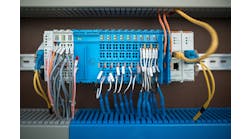According to Doug Weber, business manager, remote monitoring services, Rockwell Automation, turning data into wisdom involves five steps:
- Instrumentation and automation, which the company's been providing for decades;
- Data collection and aggregation, where the data is contextualized;
- Intelligent operations, which take the data into the cloud for collective comparison and trending;
- Data analytics and reasoning, in which organizations can make predictive decisions on how to run production, based on intelligence;
- Optimization of processes, or wisdom.
"They're also able to monitor the drives and pumps, and they can manage inventory by monitoring the levels and rate of usage." Doug Weber explains some benefits of the Virtual Support Engineer at the Rockwell Automation Solutions & Services booth in the Automation Fair exhibit hall.
"Remote monitoring and remote access are completely compatible with the Cisco-Rockwell infrastructure," explained Weber. Rockwell Automation has built its cloud software on top of the Microsoft Azure platform. It falls under the Virtual Support Engineer product umbrella, which can be used by medium-voltage-drive customers or as an OEM solution that offers secure connectivity using IT-approved communication, real-time alarming, data collection and analytics."In the cloud, IT issues are reduced," explained Weber. He offered an example. Shell is now selling LNG through its refueling stations. "They see 851 data points pulled every second at each refueling station," said Weber. "The system can go to milliseconds. They're also able to monitor the drives and pumps, and they can manage inventory by monitoring the levels and rate usage."
Rockwell also offers remote access to controls. "Access is separate from monitoring," explained Weber. "We sometimes load the agents on the same computer, but there are two separate pieces of software. With our remote access solution, you also can do some monitoring. I can set up limits so the system alarms if a tag goes out of bounds or a switch drops a certain number of packets. That's available with the
remote-access technology. In the cloud we're building dashboards and reports."
Rockwell Automation also is helping companies transition to the digital oilfield through its vMonitor solution. The monitoring and control solutions for wellhead and upstream applications combine wireless instrumentation and communication with visualization software. A common engineering, deployment and integration methodology has been developed to deliver actionable information across the enterprise to drive more-informed decision-making and improved production. Wireless telemetry, hardware, software and sensors allow for integration of solutions with minimal engineering and conceptualization.
"Thousands of these already are installed, mostly in South America for now," explained Andy Weatherhead, manager of global engineering and technology, global solutions business, for Rockwell Automation. "The cloud-based piece will be available in December, and the analysis portion is being worked on at the moment." Once the data is in the cloud infrastructure, he said, distributed workflow can be used to initiate well tests based on parameters rather than on an arbitrary schedule.
"There are a number of large players in the field optimization space, and this offers us a way to connect to their systems for data collection and aggregation," said Weatherhead.
"If you have a lot of OEM skids, you can immediately grab and contextualize that data for the maintenance schedule, for the production schedule and for the full enterprise for managing capital expenditures," explained Pat Murray, director of commercial marketing, Solutions & Services, Rockwell Automation. "With vMonitor and the digital oilfield, if we're able to grab information from the instrumentation and the controls, we're able to run models, such as three-phase and black-oil models. Now you can control that from a central location and can continually provide information on the size and quality of the field."




